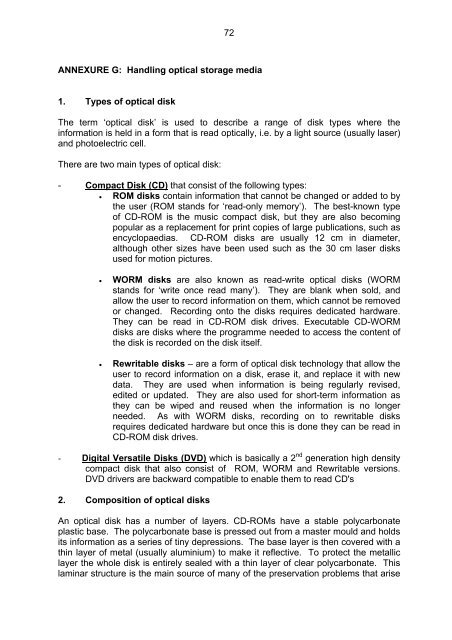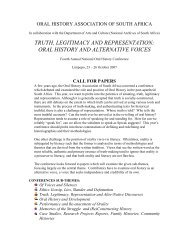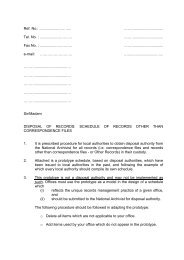managing electronic records in governmental bodies - National ...
managing electronic records in governmental bodies - National ...
managing electronic records in governmental bodies - National ...
Create successful ePaper yourself
Turn your PDF publications into a flip-book with our unique Google optimized e-Paper software.
72<br />
ANNEXURE G: Handl<strong>in</strong>g optical storage media<br />
1. Types of optical disk<br />
The term ‘optical disk’ is used to describe a range of disk types where the<br />
<strong>in</strong>formation is held <strong>in</strong> a form that is read optically, i.e. by a light source (usually laser)<br />
and photoelectric cell.<br />
There are two ma<strong>in</strong> types of optical disk:<br />
- Compact Disk (CD) that consist of the follow<strong>in</strong>g types:<br />
• ROM disks conta<strong>in</strong> <strong>in</strong>formation that cannot be changed or added to by<br />
the user (ROM stands for ‘read-only memory’). The best-known type<br />
of CD-ROM is the music compact disk, but they are also becom<strong>in</strong>g<br />
popular as a replacement for pr<strong>in</strong>t copies of large publications, such as<br />
encyclopaedias. CD-ROM disks are usually 12 cm <strong>in</strong> diameter,<br />
although other sizes have been used such as the 30 cm laser disks<br />
used for motion pictures.<br />
• WORM disks are also known as read-write optical disks (WORM<br />
stands for ‘write once read many’). They are blank when sold, and<br />
allow the user to record <strong>in</strong>formation on them, which cannot be removed<br />
or changed. Record<strong>in</strong>g onto the disks requires dedicated hardware.<br />
They can be read <strong>in</strong> CD-ROM disk drives. Executable CD-WORM<br />
disks are disks where the programme needed to access the content of<br />
the disk is recorded on the disk itself.<br />
• Rewritable disks – are a form of optical disk technology that allow the<br />
user to record <strong>in</strong>formation on a disk, erase it, and replace it with new<br />
data. They are used when <strong>in</strong>formation is be<strong>in</strong>g regularly revised,<br />
edited or updated. They are also used for short-term <strong>in</strong>formation as<br />
they can be wiped and reused when the <strong>in</strong>formation is no longer<br />
needed. As with WORM disks, record<strong>in</strong>g on to rewritable disks<br />
requires dedicated hardware but once this is done they can be read <strong>in</strong><br />
CD-ROM disk drives.<br />
- Digital Versatile Disks (DVD) which is basically a 2 nd generation high density<br />
compact disk that also consist of ROM, WORM and Rewritable versions.<br />
DVD drivers are backward compatible to enable them to read CD's<br />
2. Composition of optical disks<br />
An optical disk has a number of layers. CD-ROMs have a stable polycarbonate<br />
plastic base. The polycarbonate base is pressed out from a master mould and holds<br />
its <strong>in</strong>formation as a series of t<strong>in</strong>y depressions. The base layer is then covered with a<br />
th<strong>in</strong> layer of metal (usually alum<strong>in</strong>ium) to make it reflective. To protect the metallic<br />
layer the whole disk is entirely sealed with a th<strong>in</strong> layer of clear polycarbonate. This<br />
lam<strong>in</strong>ar structure is the ma<strong>in</strong> source of many of the preservation problems that arise
















